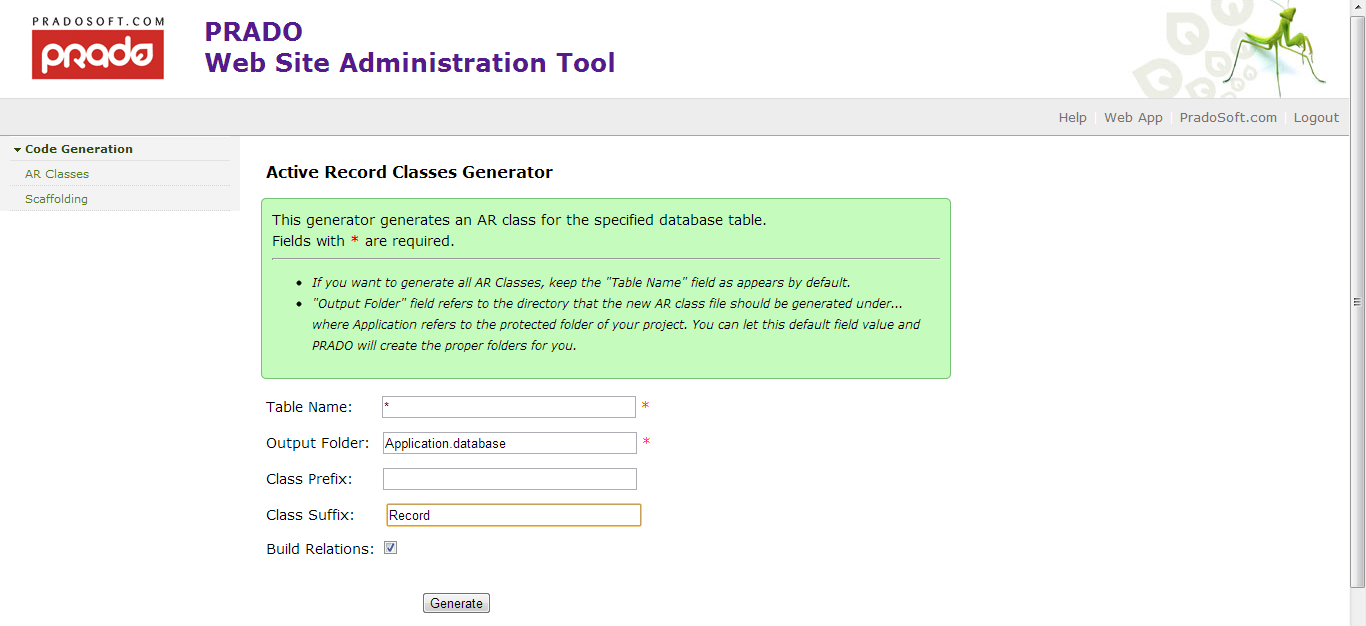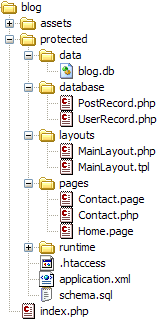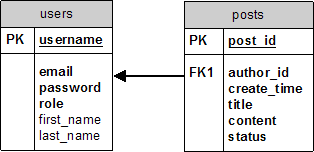Creating Active Record Classes
We need to create two Active Record classes, UserRecord and PostRecord, to represent data records in the users and posts tables, respectively. Active Record classes must extend from the base class ActiveRecord, and must define property names that matches with the field names of the corresponding table.
To better organize our directories, we create a new directory protected/database to hold the class files. We also modify our application configuration by inserting the following lines. It is equivalent to adding the directory protected/database to PHP include_path, which allows us to use the classes without explicitly including them.
<paths>
<using namespace="Application.database.*" />
</paths>
Instead of writing the classes manually, we will use the PRADO Web Site Administration Tool to generate the classes for us.
So we need to modify again our application configuration in the services section like follows:
<services>
...
<service id="wsat" class="System.Wsat.TWsatService" Password="my_secret_password" />
</services>
Then you are ready to go to: http://localhost/yoursite/index.php?wsat=TWsatLogin where you should see
the following page:

In the text field you need to type the password previosly specified in the service inclusion. This
is part of a basic security system to avoid undesirable persons to use this tool.
In order to generate AR classes you need to go to: http://localhost/divermania/index.php?wsat=TWsatGenerateAR
by clicking the proper links in the welcome page. Then you should see the following page:

In the Output Folder field we used the namespace format again, the path Application.database indicates that we want to put our class's files in the protected/database/ folder.
The * in the Table Name field means that we want to generate all AR classes, you can specify a table name instead if you want to generate just a specific AR class.
Afterward we should see the following directory structure with two new files under protected/database:

If we check the PostRecord class file, we should see something similar to the following content:
class PostRecord extends TActiveRecord
{
const TABLE='posts';
public $post_id;
public $author_id;
public $create_time;
public $title;
public $content;
public $status;
public static function finder($className=__CLASS__)
{
return parent::finder($className);
}
public static $RELATIONS = array (
'author' => array(self::BELONGS_TO, 'UserRecord', 'author_id')
);
public function __toString()
{
return $this->title;
}
}
As we see, for each field in the posts table, the class has a corresponding data member. The constant TABLE specifies the table name for the PostRecord. The static method finder() allows us to perform query and retrieve post data in terms of PostRecord objects.
Relationship Between Posts and Users
Recall that there was a foreign key relationship between the users and posts table. The entity-relationship diagram is shown below for convienence.

From the entity-relationship diagram above, we see that the posts table contains a field named author_id. This author_id field is a foreign key to the reference table users. In particular, the values in the author_id field should be of that from the users table's username field. One of the consequence of this relationship, thinking in terms of objects, is that each "post" belongs to an "author" and one "author" may have many "posts".
The static $RELATIONS property of PostRecord defines that the property $author belongs to an UserRecord. In array(self::BELONGS_TO, 'UserRecord'), the first element defines the relationship type, in this case self::BELONGS_TO. The second element is the name of related record, in this case an UserRecord.
An array of UserRecord with and its corresponding posts may be fetched as follows.
$users = UserRecord::finder()->withPosts()->findAll();
Tip:
The method withXXX() (where XXX is the relationship property name, in this case, Posts) fetches the corresponding PostRecords using a second query (not by using a join). The withXXX() method accepts the same arguments as other finder methods of TActiveRecord, e.g. withPosts('status = ?', 0).
Further detailed documentation can be found in the quickstart Active Record docs.